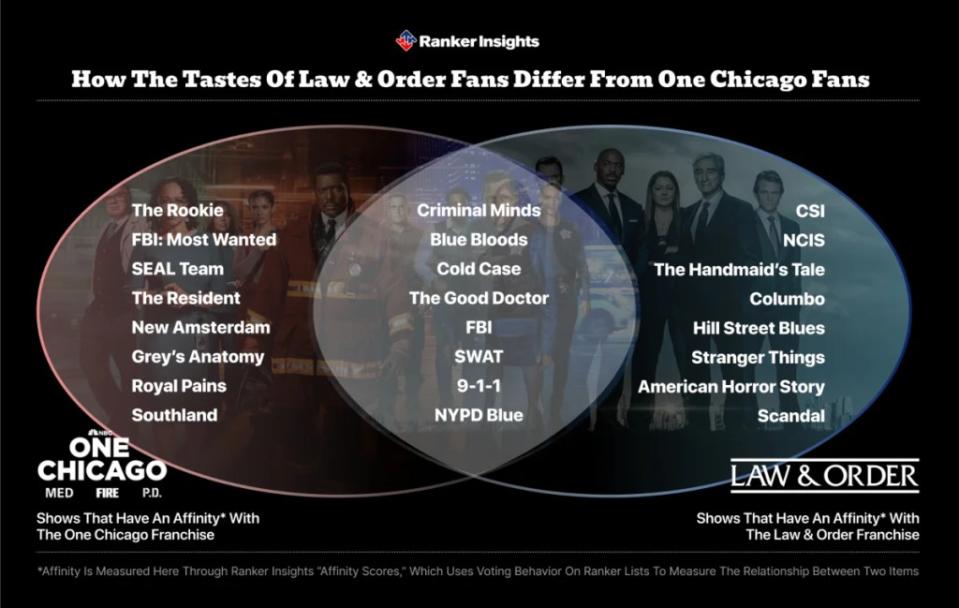Procedurals Powerhouses: NBC’s ‘Law & Order’ and ‘Chicago’ Franchises Are Drawing Distinct Audiences | Chart
The “One Chicago” franchise — a set of interconnected primetime procedurals that comprises “Chicago Fire,” “Chicago P.D.,” and “Chicago Med” — stormed back onto television this month, with new episodes of all three series taking up NBC’s primetime Wednesday night schedule.
The following night, new seasons of “Law & Order” and spinoffs “Special Victims Unit” and “Organized Crime” had premieres of their own. Dick Wolf, the producer of both TV franchises, now controls NBC’s most coveted airtime slots on not one, but two nights of the week.
That’s the nature of broadcast TV: When something works, you tend to see a lot more of it. That might make a lot of the programming we see on over-the-airwaves television look similar, but it doesn’t make its audience any less diverse. Despite the fact that “One Chicago” and “Law & Order” shows share a network, a time slot and a producer, the people watching these beloved series on Wednesdays and Thursdays have notably different tastes.
How do we know? Ranker Insights uses crowdsourced data to find “affinities” — when enough people vote the same way about both items, they develop an affinity. We found that while there’s plenty of overlap between the two franchises the “Law & Order” and “One Chicago” audiences have Affinities for different shows.
What the two shows have in common is their appeal to loyal viewers of traditional broadcast TV, and in particular, of the police procedural genre. Other cop shows that went on a decade or more, like “NYPD Blue” “Criminal Minds,” and “Blue Bloods,” are more likely to be beloved by fans of both “Law & Order” and “One Chicago” than not. Even more contemporary shows that appeal to both franchises, like “SWAT” and “9-1-1,” are focused on teams adjacent to the police. “The Good Doctor,” is the only show that breaks the pattern, being both a medical drama, rather than a police procedural, and a series that premiered as recently as 2017.

But the data tells us that these two franchises have distinct fan bases that draw in very different kinds of viewers. The “Law & Order” audience has a taste for classic cop television, including groundbreaking genre entries “Hill Street Blues” and “Columbo.” There’s also a flair among this segment for newer streaming content — that’s especially true of “Law & Order: Special Victims Unit” fans. These fans are statistically more likely to also be drawn to Netflix’s “Stranger Things” and Hulu’s “The Handmaid’s Tale,” two giants that have come to define their era in TV. This segment of streamers is especially valuable in a broadcast television ecosystem that is struggling to draw younger viewers away from their streamer competitors.
Fans of the “One Chicago” franchise exist somewhere in the divide between viewers of “Law & Order” and its spinoffs. Fans of these Chicago-based series tend to love more current broadcast shows than they do classics, but stick mostly to primetime broadcast staples over prestige TV or streaming originals. Popular ABC cop drama “The Rookie” has the favor of a statistically significant number of One Chicago fans, as does “SEAL Team,” a CBS procedural about Navy Seals. And thanks to “Chicago Med,” this franchise also appeals to fans of a wide range of current medical dramas, including NBC’s “New Amsterdam,” Fox’s “The Resident,” and ABC’s “Grey’s Anatomy.”
So which of these franchises is most popular with viewers? To answer that question, we looked at each show’s sentiment score, which takes the ratio of votes conveying positive sentiment on ranker to votes conveying negative sentiment (not unlike an approval rating).
The average score for the three “Law & Order” shows currently on the air is 54%, while One Chicago’s average score sits below the 50% point at 47%. But more interesting than this head-to-head is the fact that, for both franchises, the series get less popular the more time they’ve been on the air. For example, the original “Law & Order” series has a score of 51%; “Special Victims Unit” has 54%; and “Organized Crime,” which has only been on the air since 2021, has 58%. Similarly, “Chicago Med” is both the most recent and most popular of its franchise, trailed most closely by “Chicago P.D.,” then by “One Chicago” originator “Chicago Fire.”
This is the double-edged sword of procedural TV: When it’s popular, it’s visible everywhere, amassing an audience of millions. But unlike cord-cutters, traditional TV viewers don’t have the option to put on whatever they want when they’re watching TV. That can breed resentment with viewers who get sick of these ubiquitous shows, and the effect tends to compound over time.
When you look at broadcast TV schedules, it’s tempting to paint the medium with a broad brush. But the truth is that these shows are popular because they appeal to a diverse audience that is just as complex as the audience for any prestige streaming series. As the data always reveals, no two audiences are alike.
Ryan Mach is a content marketing manager at Ranker, a WrapPRO partner. Ranker is a source of crowdsourced rankings on the internet, where millions of people come to voice their opinions on their favorite movies, TV shows, celebrities, and more. Visit Ranker Insights for more unique information about any audience or to contact us for more information.
For more from WrapPRO partners, visit the Data and Analysis Hub.
The post Procedurals Powerhouses: NBC’s ‘Law & Order’ and ‘Chicago’ Franchises Are Drawing Distinct Audiences | Chart appeared first on TheWrap.


